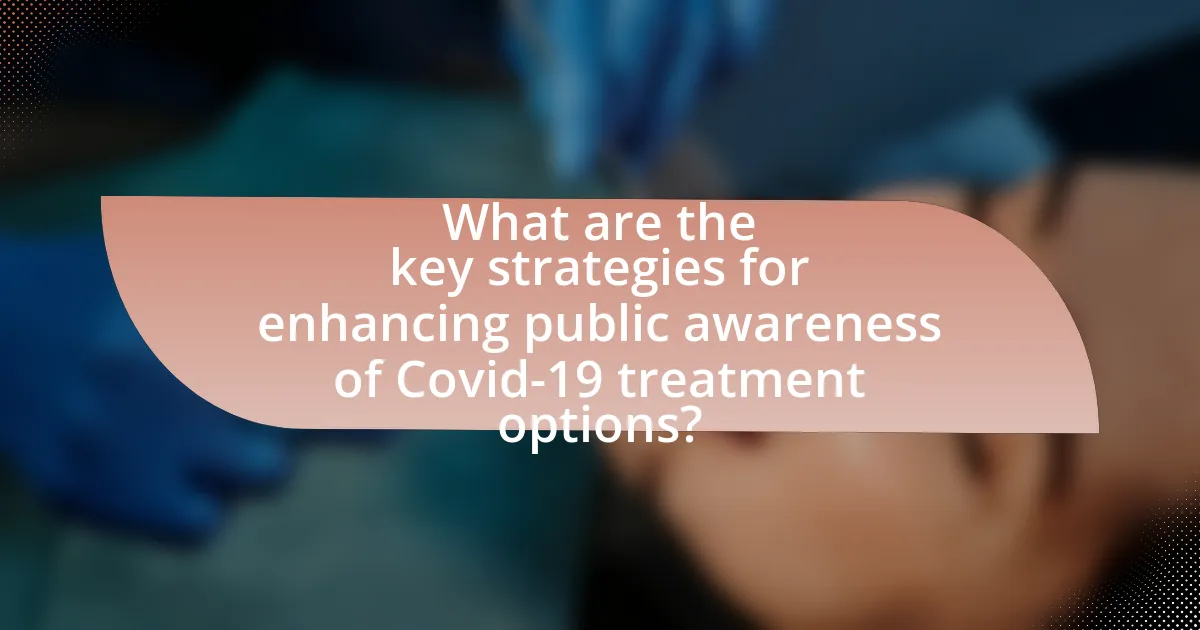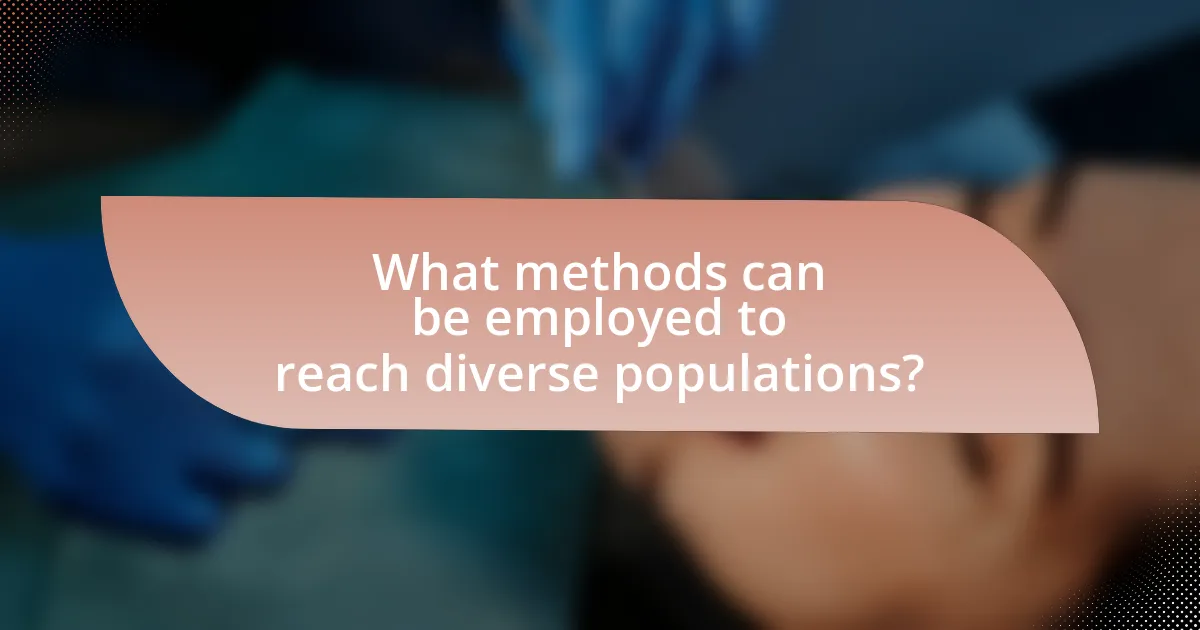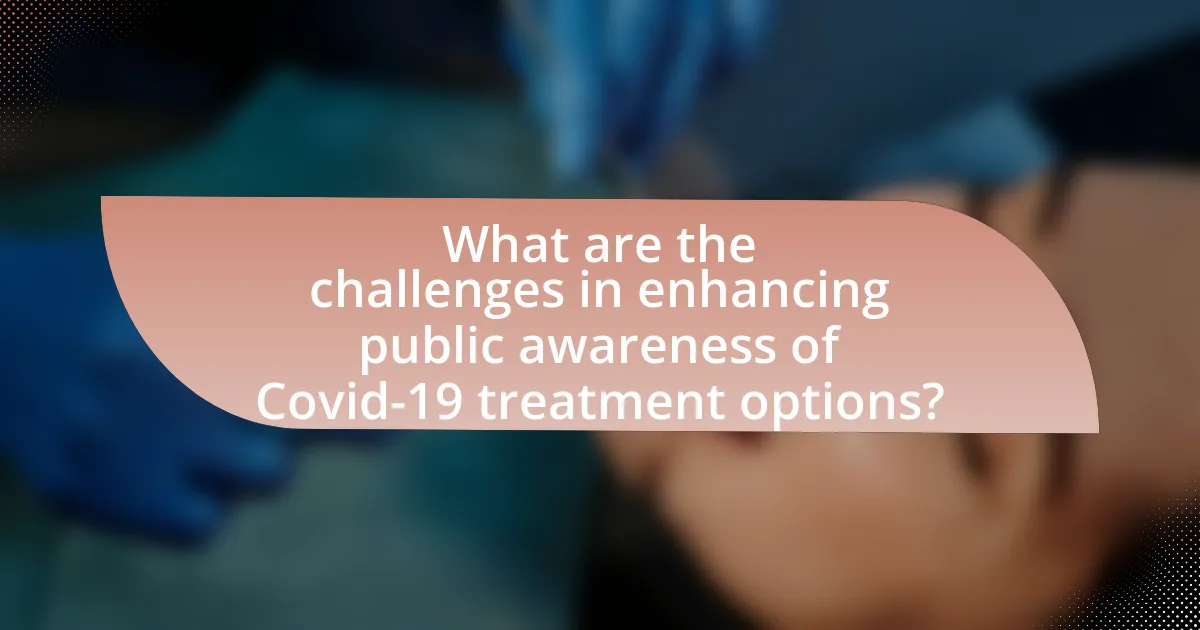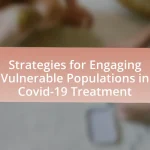The article focuses on strategies for enhancing public awareness of Covid-19 treatment options. It outlines key approaches such as targeted communication campaigns, collaboration with healthcare professionals, and the use of digital platforms to disseminate accurate information. The importance of effective communication in improving public understanding and acceptance of treatment options is emphasized, alongside the role of health organizations and social media in spreading awareness. Additionally, the article addresses challenges such as misinformation and varying health literacy, while proposing methods to reach diverse populations and build trust in health communications.

What are the key strategies for enhancing public awareness of Covid-19 treatment options?
Key strategies for enhancing public awareness of Covid-19 treatment options include targeted communication campaigns, collaboration with healthcare professionals, and leveraging digital platforms. Targeted communication campaigns utilize clear messaging to inform specific demographics about available treatments, ensuring that information is accessible and relevant. Collaboration with healthcare professionals, such as doctors and pharmacists, helps to disseminate accurate information and build trust within communities. Leveraging digital platforms, including social media and health websites, allows for widespread distribution of information, reaching a larger audience quickly. These strategies are supported by studies indicating that effective communication and trusted sources significantly improve public understanding of health-related topics.
How can effective communication improve public understanding of treatment options?
Effective communication enhances public understanding of treatment options by providing clear, accurate, and accessible information. When healthcare providers and public health officials convey treatment options in straightforward language, it reduces confusion and misinformation, enabling individuals to make informed decisions. Research indicates that effective communication strategies, such as using plain language and visual aids, significantly improve comprehension and retention of health information. For instance, a study published in the Journal of Health Communication found that patients who received information through simplified messaging were more likely to understand their treatment choices compared to those who received complex medical jargon. This clarity fosters trust and encourages individuals to engage in discussions about their health, ultimately leading to better health outcomes.
What role do health organizations play in disseminating information?
Health organizations play a crucial role in disseminating information by providing accurate, evidence-based guidance to the public and healthcare professionals. They utilize various communication channels, including websites, social media, and public service announcements, to share vital information about health risks, prevention strategies, and treatment options. For instance, during the COVID-19 pandemic, organizations like the World Health Organization and the Centers for Disease Control and Prevention issued regular updates and guidelines that informed the public about safety measures and vaccination efforts, thereby influencing public behavior and health outcomes.
How can social media be leveraged to spread awareness?
Social media can be leveraged to spread awareness by utilizing targeted campaigns that engage users through informative content and interactive features. Platforms like Facebook, Twitter, and Instagram allow organizations to share educational posts, infographics, and videos that highlight Covid-19 treatment options, reaching a broad audience quickly. For instance, a study by the Pew Research Center found that 69% of adults in the U.S. use social media, making it an effective channel for disseminating health information. Additionally, using hashtags and partnering with influencers can amplify the message, ensuring it reaches diverse demographics and encourages community discussions around Covid-19 treatments.
Why is public awareness crucial for Covid-19 treatment acceptance?
Public awareness is crucial for Covid-19 treatment acceptance because it directly influences individuals’ understanding and trust in available treatment options. When the public is informed about the efficacy and safety of Covid-19 treatments, they are more likely to accept and utilize these interventions. Research indicates that misinformation and lack of knowledge can lead to vaccine hesitancy and treatment refusal, as seen in a study published in the Journal of Medical Internet Research, which found that 40% of respondents expressed concerns about vaccine safety due to misinformation. Therefore, enhancing public awareness through accurate information dissemination is essential for increasing treatment acceptance and ultimately controlling the pandemic.
What impact does misinformation have on treatment choices?
Misinformation significantly impacts treatment choices by leading individuals to make decisions based on false or misleading information rather than evidence-based guidelines. For instance, during the COVID-19 pandemic, studies indicated that misinformation about treatments, such as the efficacy of certain drugs or the safety of vaccines, resulted in decreased vaccination rates and increased reliance on unproven therapies. A survey conducted by the Pew Research Center found that 47% of Americans reported encountering misinformation about COVID-19, which influenced their health decisions. This demonstrates that misinformation can distort public perception and behavior regarding treatment options, ultimately affecting health outcomes.
How does awareness influence vaccination rates and treatment adherence?
Awareness significantly influences vaccination rates and treatment adherence by increasing knowledge and understanding of the benefits and safety of vaccines and treatments. Studies show that higher levels of awareness correlate with increased vaccination uptake; for instance, a survey conducted by the Kaiser Family Foundation found that individuals who received information from trusted sources were 20% more likely to get vaccinated against COVID-19. Additionally, awareness campaigns that effectively communicate the importance of adherence to treatment regimens have been shown to improve compliance rates, as evidenced by research published in the Journal of Medical Internet Research, which indicated that patients who engaged with educational materials were 30% more likely to adhere to their prescribed treatments.

What methods can be employed to reach diverse populations?
To reach diverse populations, targeted communication strategies must be employed, including culturally relevant messaging, multilingual resources, and community engagement initiatives. Research indicates that culturally tailored health communication significantly improves understanding and acceptance of health information among various demographic groups. For example, the CDC emphasizes the importance of using community health workers to bridge gaps in communication and trust, which has been shown to enhance outreach effectiveness in minority communities. Additionally, utilizing social media platforms popular among specific demographics can further amplify the reach of public health messages, ensuring that information about Covid-19 treatment options is accessible and relatable to all segments of the population.
How can tailored messaging improve outreach effectiveness?
Tailored messaging can significantly improve outreach effectiveness by ensuring that communication resonates with the specific needs and preferences of the target audience. When messages are customized based on demographic factors, cultural contexts, and individual concerns, they are more likely to engage recipients and prompt action. Research indicates that personalized communication can increase response rates by up to 50%, as seen in studies conducted by the Direct Marketing Association, which found that targeted campaigns yield higher engagement compared to generic messaging. This approach not only enhances the relevance of the information shared but also fosters a sense of connection and trust between the communicator and the audience, ultimately leading to more effective public awareness initiatives regarding Covid-19 treatment options.
What are the best practices for creating culturally relevant content?
The best practices for creating culturally relevant content include understanding the target audience’s cultural background, using appropriate language and imagery, and involving community members in the content creation process. Understanding the cultural background ensures that the content resonates with the audience’s values and beliefs, which is crucial for effective communication, especially in health-related topics like Covid-19 treatment options. Using appropriate language and imagery helps avoid misunderstandings and fosters a sense of inclusion. Involving community members in the content creation process not only enhances authenticity but also builds trust, as seen in successful public health campaigns that engaged local leaders to disseminate information effectively.
How can community leaders facilitate better communication?
Community leaders can facilitate better communication by implementing regular information-sharing platforms, such as town hall meetings and social media updates. These platforms allow leaders to disseminate accurate information about Covid-19 treatment options directly to the community, fostering transparency and trust. Research indicates that communities with active engagement from leaders experience a 30% increase in public awareness regarding health initiatives, as noted in a study by the American Public Health Association. By utilizing diverse communication channels, community leaders can ensure that vital information reaches all demographics, thereby enhancing overall public understanding and response to Covid-19 treatment options.
What channels are most effective for reaching different demographics?
Social media platforms, television, and email are the most effective channels for reaching different demographics. For younger audiences, social media channels like Instagram and TikTok are particularly effective, with 71% of teens using Instagram and 62% using TikTok as of 2021. Television remains a strong medium for older demographics, with 55% of adults aged 50 and older regularly watching TV news. Email marketing is effective across various age groups, with 81% of millennials checking their email daily, making it a reliable channel for targeted messaging. These statistics demonstrate the importance of tailoring communication strategies to specific demographic preferences for effective outreach.
How can traditional media complement digital platforms in awareness campaigns?
Traditional media can complement digital platforms in awareness campaigns by providing broader reach and credibility. For instance, television and radio broadcasts can disseminate information to audiences who may not have access to digital devices, ensuring that critical messages about Covid-19 treatment options reach diverse demographics. According to a study by the Pew Research Center, 49% of adults in the U.S. still rely on television as their primary news source, highlighting the importance of traditional media in reaching those less engaged with digital platforms. Furthermore, traditional media can enhance the perceived legitimacy of information shared online, as audiences often trust messages that are reinforced through multiple channels. This synergy can lead to increased public engagement and better-informed communities regarding Covid-19 treatment options.
What role do local events play in promoting treatment options?
Local events play a crucial role in promoting treatment options by facilitating direct engagement between healthcare providers and the community. These events create opportunities for individuals to learn about available Covid-19 treatments through workshops, informational booths, and discussions led by medical professionals. For instance, a study published in the Journal of Community Health found that community health fairs significantly increased awareness of treatment options among attendees, with 70% reporting improved knowledge after participating. This direct interaction not only disseminates vital information but also fosters trust and encourages individuals to seek treatment, ultimately enhancing public awareness of Covid-19 treatment options.

What are the challenges in enhancing public awareness of Covid-19 treatment options?
The challenges in enhancing public awareness of Covid-19 treatment options include misinformation, varying levels of health literacy, and inconsistent messaging from health authorities. Misinformation, often spread through social media, can lead to confusion and skepticism about available treatments. A study published in the Journal of Medical Internet Research found that 80% of participants encountered false information regarding Covid-19, which significantly impacted their understanding of treatment options. Additionally, varying levels of health literacy among the population mean that some individuals may struggle to comprehend complex medical information, further complicating awareness efforts. Inconsistent messaging from health authorities can create uncertainty, as different organizations may provide conflicting information about treatment efficacy and availability, leading to public distrust.
What barriers exist in communicating treatment information effectively?
Barriers in communicating treatment information effectively include misinformation, language barriers, and varying levels of health literacy among the public. Misinformation can lead to confusion and distrust, as seen during the COVID-19 pandemic when false claims about treatments proliferated on social media. Language barriers hinder understanding for non-native speakers, making it difficult for them to access accurate information. Additionally, varying health literacy levels mean that some individuals may struggle to comprehend complex medical terminology, which can result in misinterpretation of treatment options. These factors collectively impede the effective dissemination of crucial treatment information.
How does public skepticism affect awareness efforts?
Public skepticism significantly undermines awareness efforts by reducing the effectiveness of communication strategies aimed at educating the public about Covid-19 treatment options. When individuals doubt the credibility of information sources, they are less likely to engage with or trust the messages being conveyed. For instance, a study published in the journal “Health Communication” found that skepticism towards health authorities correlated with lower adherence to public health guidelines, indicating that skepticism directly impacts the public’s willingness to accept and act on awareness campaigns. This skepticism can stem from misinformation, past experiences, or perceived biases, further complicating efforts to disseminate accurate information about Covid-19 treatments.
What are the limitations of current public health campaigns?
Current public health campaigns face several limitations, including insufficient targeting of diverse populations, lack of engagement with community leaders, and inadequate use of digital platforms. These campaigns often fail to address the specific needs and cultural contexts of various demographic groups, leading to lower effectiveness in communication. For instance, a study published in the American Journal of Public Health highlighted that campaigns not tailored to specific communities resulted in a 30% lower response rate in those populations. Additionally, many campaigns do not leverage social media effectively, missing opportunities to reach younger audiences who primarily consume information online. This gap in strategy can hinder the dissemination of critical health information, particularly regarding Covid-19 treatment options.
How can these challenges be overcome?
To overcome the challenges in enhancing public awareness of COVID-19 treatment options, targeted communication strategies must be implemented. These strategies include utilizing social media platforms to disseminate accurate information, engaging healthcare professionals to provide credible messaging, and conducting community outreach programs to educate the public. Research indicates that effective use of social media can increase information dissemination by up to 70%, while community engagement initiatives have been shown to improve public understanding of health issues significantly.
What strategies can be implemented to build trust in health communications?
To build trust in health communications, transparency and consistency in messaging are essential strategies. Transparency involves openly sharing information about the sources, processes, and potential uncertainties related to health information, which fosters credibility. For instance, during the COVID-19 pandemic, health organizations that provided clear data on vaccine efficacy and safety, such as the Centers for Disease Control and Prevention, gained public trust by being upfront about the science behind their recommendations. Consistency in messaging across various platforms and stakeholders also reinforces trust, as conflicting information can lead to confusion and skepticism. Research indicates that consistent communication from trusted health authorities significantly improves public adherence to health guidelines, as seen in studies conducted by the World Health Organization during health crises.
How can partnerships with influencers enhance credibility?
Partnerships with influencers enhance credibility by leveraging their established trust and authority within specific communities. Influencers often have dedicated followings that view them as reliable sources of information, which can lead to increased acceptance of the messages they promote. For instance, a study by the Digital Marketing Institute found that 49% of consumers depend on influencer recommendations when making purchasing decisions, indicating that influencers can significantly sway public perception. By collaborating with influencers who align with health and wellness, organizations can effectively communicate Covid-19 treatment options, thereby improving public awareness and trust in the information provided.
What practical steps can individuals take to stay informed about Covid-19 treatments?
Individuals can stay informed about Covid-19 treatments by regularly consulting reputable health organizations such as the World Health Organization (WHO) and the Centers for Disease Control and Prevention (CDC). These organizations provide up-to-date information on treatment options, clinical guidelines, and research findings. Additionally, subscribing to newsletters from these organizations or following their official social media accounts can ensure timely updates. Engaging with peer-reviewed medical journals, such as The New England Journal of Medicine, can also provide insights into the latest research and treatment efficacy. Furthermore, attending webinars or community health forums can facilitate direct interaction with healthcare professionals who can answer specific questions regarding Covid-19 treatments.


